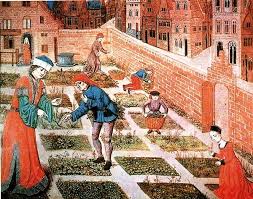
Herbs, vegetable or medicines are cultivated in medieval gardens, occasionally called "orchards", usually in divides into several gardens. The Orchard, a really pleasant garden in the Middle Ages in which various trees are planted, fruit trees, shrubs, groves and rose-trees. - The herb bed, planted with tinctorial, condimental and medical herb...

Herbs, vegetable or medicines are cultivated in medieval gardens, occasionally called "orchards", usually in divides into several gardens. The Orchard, a really pleasant garden in the Middle Ages in which various trees are planted, fruit trees, shrubs, groves and rose-trees. - The herb bed, planted with tinctorial, condimental and medical herbs. - The kitchen garden whose borders are encompassed with bricks, tiles or willow stems is grown with "pot herbs" leguminous plants or roots. The "Préau" can have different meanings according to the author (arbour) In general it is a small garden closed on three sides by lattice up which roes-trees climb. People could sit there on green benches among daisies, strawberries and aquilegia. The flowered meadow is an area sown with wild flowers that will be an inspiration for the millefleurs tapestries, late XVIth century. Among these flowers : the violet, the periwinkle, the primrose, the kitchen garden, a preserved area for the family mother. In a way, they express a hidden part of medieval civilization, a part as discreet as the perfume of calamint, fascinating enough for us to make a pause
Subcategories
Aromatic herbs
Herbs: parsley that cooking soup, broth with egg accompanies porated, green or arboulastes omelettes.
The gardens are filled with herbs that intersect, but do not sell themselves. Thus, we pick or cultivated varieties of celery. The ache, or wild celery, lovage, pushing their big cut in high tufts in the gardens leaves. Their fragrance when crumpled leaves, is rich and powerful.
The aurone, which would later be called musket because of its special properties to treat burns powder, is a small shrub with deeply dissected leaves.
Among the tall plants that grow on their own and return without special care from one year to the other, there are also tansy. Rubbed, the leaves cut tansy (whether flat or tense), emit a strong odor, limit edible. Tansy is nevertheless consumed donuts before being confined, in later periods, a single function de-worming medication.
Cultured as rare flowers marjoram or oregano. Savory, considered aphrodisiac, with some success. But this range of perfumes is rather held by hyssop, whose blue poles stand and withstand even severe frosts, and sage, whose Latin name salvia, saving, provides a wide reputation and use . Mention may also be flowers; lily, purple, pink gladiolus and ... garlic and onion.herbs vegetables
Vegetables are eaten by peasants and workers as close to the ground. It feeds the winter leeks, cabbage and beans, dried lentils, "chestnuts", "mushrooms", the bread can be scarce at the end of winter. Herbs that grow when the weather relented bring freshness, vitamin C and a complement to a monotonous diet. Mash, also called mache, made salads late winter, oxalis, blooming in the woods, eaten raw, burdock, nettle, the Atriplexes make good porated, and if necessary, it uses the centipede fern, young shoots of asparagus or wild broom breakfast holly, various cress (water and earth), the creeping buttercup, and even bouchibarbe. In addition to the daily bread, herbs provide fiber and vitamins necessary for digestion and health and the rest of the year seasonal vegetables: garlic, artichoke, celery, turnip, radish, onions, parsnips, chard, lentils, beans, European squash, cucumber, chickpeas, celery, carrot, cabbage, chard, fennel, spinach, leeks, peas, lettuce, garlic, onions, shallots, eggplant ..., tansy, catnip, meum, squill , Seseli, maceron, tansy, orach, mauve, squill, the meum, the Seseli, cabaret, the épurge ... melon,
Medicinal herbs
Herbs, both medicinal and food for most of them (see the sage, who is regarded as a sort of panacea that can cure all), are regularly consumed, without knowing whether the primary motivation of eater is to feed or heal. Tansy is nevertheless consumed donuts before being confined, in later periods, a single function de-worming medication. Medical prescriptions often look at the plans, and potions found in the same plants from the garden.
The virtues of plants are known to scholars who establish dictionaries. Platearius described in the Book of Simple Medicines 420 different plants, some of which are as common as cabbage, and other rare and exotic.



